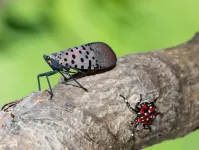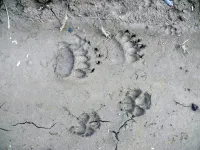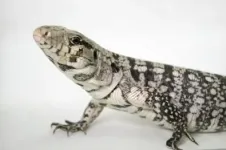(Press-News.org) Annapolis, MD; February 17, 2021--When the invasive spotted lanternfly arrived in the United States in 2014, it was immediately recognized for the threat it posed to native plants and crops. A community of researchers and experts in science, agriculture, and government sprang into action to respond, improving our chances for containing the pest and curbing its potential for damage.
While the effort continues, a new collection curated by the Entomological Society of America's family of journals showcases the growing body of research that is helping us understand the spotted lanternfly's biology and how to contain it. The collection features 25 articles published in ESA journals since 2015, with 16 of them new additions since June 2020.
The spotted lanternfly (Lycorma delicatula) is a treehopper native to Asia but was discovered in Pennsylvania in 2014, and it has since spread to five other northeastern states. Its primary host is tree of heaven (Ailanthus altissima), but it is known to feed on more than 100 types of plants--mostly trees, shrubs, and stout vines. Valuable crops the spotted lanternfly can damage include grapes, apples, and peaches, as well as hardwood trees. One study of the lanternfly's potential range in the U.S., based on environmental and climatic conditions, suggests most of New England and the mid-Atlantic states as well as parts of the central U.S. and Pacific Northwest are vulnerable to establishment of the spotted lanternfly if it finds its way there.
Melody Keena, Ph.D., research entomologist at the U.S. Forest Service, is co-editor-in-chief of the ESA journal Environmental Entomology and compiled the collection on spotted lanternfly. Like many, Keena was struck by the insect's potential when she first learned about it. "I was surprised because it is so much bigger than the treehoppers that are native. I was also surprised by the large numbers congregating on single trees," she says.
Early on, the U.S. Department of Agriculture's Animal Plant Health Inspection Service and the state of Pennsylvania led the charge, says Keena, while more states and groups have joined in as the spotted lanternfly has spread.
"Both federal and university groups--with Pennsylvania State University taking the early lead--have developed a lot of knowledge and tools rapidly for dealing with this pest, as this collection demonstrates," Keena says.
Engaging the public has been critical as well.
"The public has taken an interest in it because of the major nuisance the adults are in the fall, with all the honey dew the lanternflies produce and black sooty mold that grows on it," Keena says. "They are willing to help in any way they can, like removing its egg masses or smashing adults they find or allowing researchers to use their property."
The research collection showcases progress made so far, as continued awareness and research will be necessary to slow the spotted lanternfly's spread.
"Multiple tools for trapping and killing spotted lanternfly have been developed but still need improvement, especially for adults. Biological control organisms have been found and are being evaluated. Prospects for managing it are good," says Keena. "We don't yet know how far it will successfully be able to spread, but there are indications that it may have some climatic limitations. Current work to understand how humans are aiding its spread, and how to cut off those avenues, is underway."
INFORMATION:
The ESA spotted lanternfly collection is available at http://www.academic.oup.com/ee/pages/research-on-spotted-lanternfly, featuring 25 articles published across the ESA family of journals. Several articles in the collection have also been featured in accompanying posts at the Entomology Today blog, available at http://www.entomologytoday.org/tag/slf-collection.
CONTACT: Joe Rominiecki, jrominiecki@entsoc.org, 301-731-4535 x3009
ABOUT: ESA is the largest organization in the world serving the professional and scientific needs of entomologists and people in related disciplines. Founded in 1889, ESA today has more than 7,000 members affiliated with educational institutions, health agencies, private industry, and government. Headquartered in Annapolis, Maryland, the Society stands ready as a non-partisan scientific and educational resource for all insect-related topics. ESA publishes eight internationally acclaimed journals that provide unsurpassed coverage of the broad science of entomology, as well as the quarterly magazine American Entomologist. For more information, visit http://www.entsoc.org and http://www.insectscience.org.
When there is a choice, wolves in Mongolia prefer to feed on wild animals rather than grazing livestock. This is the discovery by a research team from the University of Göttingen and the Senckenberg Museum Görlitz. Previous studies had shown that the diet of wolves in inland Central Asia consists mainly of grazing livestock, which could lead to increasing conflict between nomadic livestock herders and wild predatory animals like wolves. The study has been published in the journal Mammalian Biology.
Around three million people live in Mongolia, making it the most sparsely populated country in the world. In addition, there are more than 40 million grazing animals. These animals are not just a source of food but also the ...
By 2030 only EV's will be in production, meaning manufacturers are racing to create a high-energy battery that's affordable and charges efficiently, but conventional battery cathodes cannot reach the targets of 500Wh/Kg
Lithium-excess cathodes offer the ability to reach 500Wh/Kg but unlocking their full capacity means understanding how they can store charge at high voltages.
A new X-ray study lead by WMG, University of Warwick has resolved how the metals and oxygen facilitate the charge storage at high voltages.
High energy storage batteries for EVs need high capacity battery cathodes. New lithium-excess magnesium-rich cathodes are expected to replace existing nickel-rich cathodes but understanding how the magnesium and oxygen accommodate charge storage at high ...
As investors set their sights on the mineral resources of the deep seabed, the International Seabed Authority (ISA) is developing regulations that will govern their future exploration and possible exploitation. A new IASS Policy Brief, published in cooperation with the Federal Environment Agency (UBA), presents three recommendations to ensure that future deep seabed mining would be to the common benefit all humankind, as required by international law.
The ecosystems of the deep ocean are complex and provide a wide range of benefits to humankind. Oceans soak up carbon dioxide and act as a natural buffer to global warming in addition to regulating the climate and serving as an important ...
CHAMPAIGN, Ill. -- Researchers report that 4-6-year-old children who walk further than their peers during a timed test - a method used to estimate cardiorespiratory health - also do better on cognitive tests and other measures of brain function. Published in the Journal of Clinical Medicine, the study suggests that the link between cardiorespiratory fitness and cognitive health is evident even earlier in life than previously appreciated.
Most studies of the link between fitness and brain health focus on adults or preadolescent or adolescent children, said doctoral student Shelby Keye, who led the new research with Naiman Khan, a professor of kinesiology and ...
CHAMPAIGN, Ill. -- Workers with science, technology, engineering and math backgrounds are typically in high demand - but the demand isn't so overwhelming that a "skills gap" exists in the labor market for information technology help desk workers, one of the largest computer occupations in the U.S., says new research from a University of Illinois Urbana-Champaign expert who studies labor economics and work issues.
The incidence of prolonged hiring difficulties for STEM workers is modest, with only 11%-15% of IT help desks in the U.S. showing vacancy patterns that might be consistent with persistent hiring frictions, said Andrew Weaver, a professor ...
The mechanism that keeps arterial blood pressure stable in black and white tegu lizards (Salvator merianae) even as their body temperature varies substantially is more efficient at lower than higher external temperatures, contrary to what has always been believed, and vascular regulation plays a key role in pressure adjustments, according to an article published in PLOS ONE by researchers at the Federal University of São Carlos (UFSCar) in the state of São Paulo, Brazil. The research was supported by FAPESP.
The findings pave the way for more investigation of the physiology of ectothermic animals, which rely on external environmental factors to regulate body temperature, and of novel applications for the method used in ...
A new study concluding out of Lusaka, Zambia last summer has found that as many as 19% (almost 1 in 5) of recently-deceased people tested positive for COVID-19.
A new Boston University School of Public Health (BUSPH) study in Lusaka, Zambia's capital, challenges the common belief that Africa somehow "dodged" the COVID-19 pandemic.
The findings indicate that low numbers of reported infections and deaths across Africa may simply be from lack of testing, with the coronavirus taking a terrible but invisible toll on the continent.
Published in The BMJ, the study found that at least ...
Neutralizing antibodies develop within two weeks of a SARS-CoV-2 infection, but their durability and intensity can vary by individual, prompting concerns about the prospects of long-lasting immunity and efficacy of COVID-19 vaccines.
In a PLOS ONE paper, published online February 11, 2021, researchers at University of California San Diego School of Medicine report that individual immune response to SARS-CoV-2, the virus that causes COVID-19, may be limited by the major histocompatibility complex or MHC, a set of variable genes that code for cell surface proteins essential for the adaptive immune system.
Specifically, ...
Dreams take us to what feels like a different reality. They also happen while we're fast asleep. So, you might not expect that a person in the midst of a vivid dream would be able to perceive questions and provide answers to them. But a new study reported in the journal Current Biology on February 18 shows that, in fact, they can.
"We found that individuals in REM sleep can interact with an experimenter and engage in real-time communication," said senior author Ken Paller (@kap101) of Northwestern University. "We also showed that dreamers are capable of comprehending questions, engaging in working-memory operations, and producing answers. ...
Dogs may be able to recognize their own body as an obstacle and also understand the consequences of their own actions, according to a study involving 32 pet dogs published in Scientific Reports.
Previous research has shown that dogs have complex cognitive capabilities, such as empathy and social learning, but whether they also show any form of self-awareness was not clear.
Péter Pongrácz and Rita Lenkei tested dogs in a 'body as an obstacle' task, during which the dogs had to pick up and give a toy to their owner, whilst standing on a small mat to which the toy was attached. In order to lift the toy, the dogs had to leave the mat.
The authors found that dogs left the mat more frequently and sooner when the ...






